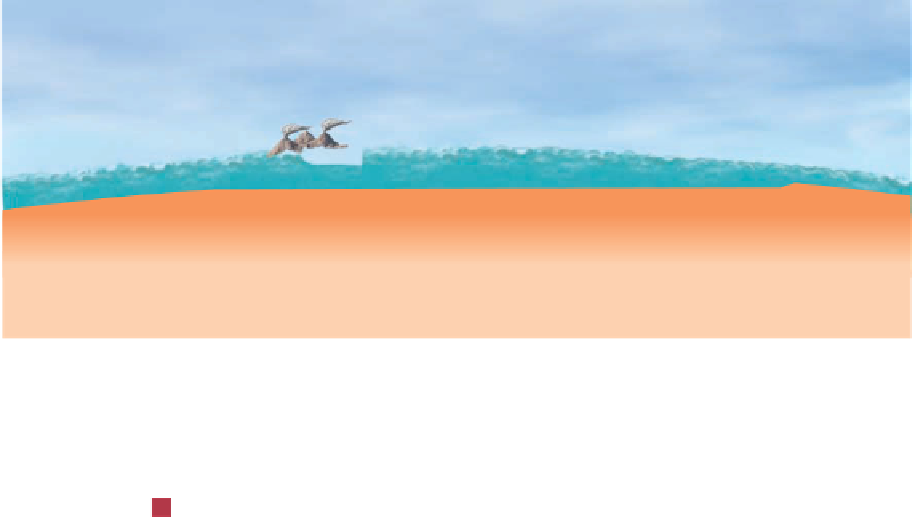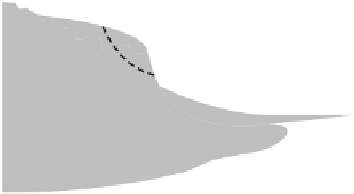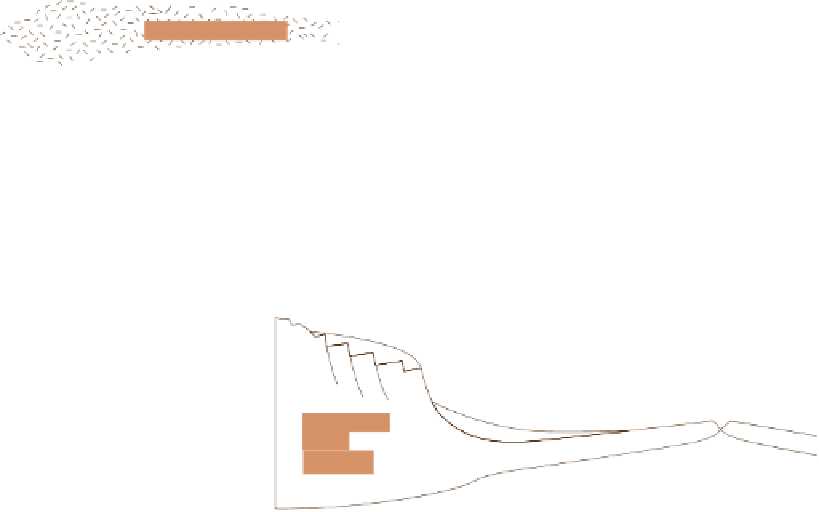Geology Reference
In-Depth Information
Active
continental
margin
Narrow
continental
shelf
Passive
continental
margin
Peru-
Chile
Trench
Andes
Mountains
Plate
boundary
Broad
continental shelf
Plate boundary
South America
Pacific Ocean
Atlantic Ocean
South American plate
Plate
movement
Plate
movement
Plate
movement
Subduction zone
(shallow and deep
earthquakes)
Mid-Atlantic Ridge
(spreading ridge)
Asthenosphere
Passive
continental
margin
a
Active and passive continental margins along the west and east
coasts of South America. Notice that the passive margins are much
wider than active margins. Seafl oor sediment is not shown.
Deep-ocean basin
Sediment
Submarine canyon profile
Continental shelf
Continental slope
b
More detailed view of a passive continental
margin showing fractures that formed during
rifting and sediment accumulation. Sediment
is also found on the shelves and in oceanic
trenches along active continental margins. The
vertical dimension in this illustration has been
greatly exaggerated.
Continental rise
Oceanic ridge
Continental
crust
(granitic)
Oceanic
crust
(basaltic)
Asthenosphere
◗
Figure 9.9
Passive and Active Continental Margins
bounded by transform faults rather than a subduction
zone. However, plate convergence and subduction still take
place in the Pacifi c Northwest along the continental mar-
gins of northern California, Oregon, and Washington.
The continental margins of eastern North America and
South America differ considerably from their western mar-
gins. For one thing, they possess broad continental shelves,
as well as a continental slope and rise; also, vast, fl at
abyssal
plains
are present adjacent to the rises (Figure 9.9). Further-
more, these
passive continental margins
are within a plate
rather than at a plate boundary, and they lack the volcanic
and seismic activity found at active continental margins.
Nevertheless, earthquakes do take place occasionally at these
margins.
Active and passive continental margins share some
features, but they are notably different in the widths of
their continental shelves, and active margins have an oce-
anic trench but no continental rise. Why the differences?
At both types of continental margins, turbidity currents
transport sediment into deeper water. At passive margins,
the sediment forms a series of overlapping submarine fans
and thus develops a continental rise, whereas at an active
margin, sediment is simply dumped into the trench and no
rise forms. The proximity of a trench to a continent also
explains why the continental shelves of active margins are
so narrow. In contrast, land-derived sedimentary deposits
at passive margins have built a broad platform extending
far out into the ocean.
WHAT FEATURES ARE FOUND
The seafl oor has an average depth of 3.8 km, so most of it
lies far below the depth of sunlight penetration, which is
generally less than 100 m. Accordingly, the deep seafl oor is
completely dark, no plant life exists, the temperature is just
above freezing, and the pressure varies from 200 to more
than 1000 atmospheres depending on depth. In fact, biologic
productivity is low on the deep seafl oor with the exception
of hydrothermal vent communities (discussed later).
Scientists have descended to the greatest oceanic depths,
submarine ridges, and elsewhere in submersibles, so they
have observed some of the seafl oor. Nevertheless, much of
the seafl oor has been studied only by echo sounding, seismic
profi ling, sampling of seafl oor sediments and oceanic crust,
and remotely controlled submersibles.
Beyond the continental rises of passive continental margins
are
abyssal plains,
flat surfaces covering vast areas of the
seafloor. In some areas, they are interrupted by peaks ris-
ing more than 1 km, but abyssal plains are nevertheless the
























Search WWH ::

Custom Search